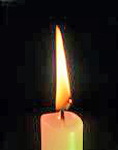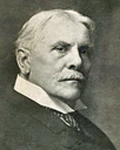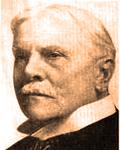RIGHTLY DIVIDING THE WORD OF TRUTH
Dr. Cyrus Ingerson Scofield Chapter
4:
THE TWO RESURRECTIONS "The purpose of this pamphlet is to indicate
the more important divisions of the Word of truth."
The Introduction and previous chapters of Rightly Dividing
may be accessed via links in our
Library.
In this pamphlet,
Dr. Scofield outlines some basic and very important distinctions in Scripture that must be acknowledged for proper understanding. Among these are distinctions that are of particular concern to the messianic community. Perhaps the two most important distinctions in this regard are those between Israel and the Church and between the various ages in God's dealings with mankind, the latter of which are often referred to as "dispensations," each of which has been initiated by a covenant that radically altered God's expectations of those with whom He made the covenant and with those who subsequently entered into it. Many reject the doctrine of dispensationalism, often on the grounds that it was invented by C.I. Scofield, a late eighteenth - early nineteenth century American minister. By the same token, many have rejected the doctrine of salvation by grace alone through faith alone on the same grounds: It was invented by Luther. Of course, Luther didn't invent the doctrine; it was in Scripture all the time. Similarly, Scofield didn't invent dispensationalism; it was in Scripture all the time. He merely brought it to the notice of millions, particularly through The Scofield Reference Bible, first published in 1909. Furthermore, there were many before him that recognized distinctions between the ages and developed the concept to varying degrees, at least as far back as Justin Martyr (A.D. 110-165) - virtually on the heels of Paul, who so copiously expounded on the subject. So there really was an unbroken line, or virtually unbroken line, of church leaders and theologians who recognized these "dispensations." In 1885, Scofield issued Rightly Dividing the Word of Truth, a pamphlet that "set the direction for his teaching and, through numerous editions, the agenda for a major segment of American fundamentalism."1 With this Shofar, the AMC is pleased to continue presenting the entirety of Rightly Dividing the Word of Truth, a concise aid that will help us in rightly dividing the word of truth (2 Timothy 2:15). - ed.
 | RIGHTLY DIVIDING
THE WORD OF TRUTH |  | 
C.I. Scofield
|
*
Chapter 4:
THE TWO RESURRECTIONS
But the rest of the dead lived not again until
the thousand years were finished
~ Revelation 20:5a ~ |
The Word of
truth teaches in the clearest and most positive terms that all of the dead
will be raised. No doctrine of the faith rests upon a more literal and
emphatic body of Scripture authority than this, nor is any more vital to
Christianity. But if there be no resurrection of
the dead, then is Christ not risen. And if Christ be not risen, then is our
preaching vain, and your faith is also vain (I Cor. 15:13-14).
But it is important to observe that the Scriptures do not teach that all the
dead are raised at one time. A partial resurrection of saints has already
occurred. And the graves were opened; and many
bodies of the saints which slept arose, and came out of the graves after his
resurrection, and went into the holy city, and appeared unto many
(Matt. 27:52-53).
Two resurrections, differing in respect of time and of those who are the
subjects of the resurrection, are yet future. These are variously
distinguished as the resurrection of life,
and the resurrection of damnation,
the resurrection of the just and the unjust,
etc. The following Scriptures refer to this important subject.
Marvel not at this: for the hour is coming, in the
which all that are in the graves shall hear his voice, and shall come forth;
they that have done good, unto the resurrection of life; and they that have
done evil, unto the resurrection of damnation (John 5:28-29). If
it be objected that the word hour would
indicate a simultaneous resurrection of these two classes, it is answered
that the "hour" of verse 25 has already lasted eighteen hundred years. (See
also "day," in 2 Pet. 3:8; 2 Cor. 6:2; John 8:56).
But when thou makest a feast, call the poor, the
maimed, the lame, the blind: and thou shalt be blessed; for they cannot
recompense thee: for thou shalt be recompensed at the resurrection of the
just (Luke 14:13-14). In this passage our Lord speaks of the
first resurrection only. In I Corinthians 15 the distinction still further
appears: For as in Adam all die, even so in Christ
shall all be made alive. But every man in his own order: Christ the
firstfruits; afterward they that are Christ's at his coming (I
Cor. 15:22-23).
| But I would not have you to be ignorant,
brethren, concerning them which are asleep, that ye sorrow not, even
as others which have no hope. For if we believe that Jesus died and
rose again, even so them also which sleep in Jesus will God bring with
him. For this we say unto you by the word of the Lord, that we which
are alive and remain unto the coming of the Lord, shall not prevent
(precede] them which are asleep. For the Lord himself shall descend
from heaven with a shout, with the voice of the archangel, and with
the trump of God: and the dead in Christ shall rise first.
~ I Thess. 4:13-16 ~ |
If the apostle had in mind a resurrection of all the dead,
how could he speak of attaining it by any means,
since he could not possibly escape it?
In Revelation 20:4-6 the two resurrections are again mentioned together,
with the important addition of the time which intervenes between the
resurrection of the saved and of the unsaved.
| 4. And I saw thrones, and they sat upon
them, and judgment was given unto them: and I saw the souls of them
that were beheaded for the witness of Jesus, and for the word of God,
and which had not worshipped the Beast neither his image, neither had
received his mark upon their foreheads, or in their hands; and they
lived and reigned with Christ a thousand years. 5. But the rest of the
dead lived not again until the thousand years were finished. This is
the first resurrection. 6. Blessed and holy is he that hath part in
the first resurrection: on such the second death hath no power, but
they shall be priests of God and of Christ, and shall reign with him a
thousand years. |
Verses 12 and 13 describe the second resurrection - that
"unto damnation."
The testimony of Scripture, then, is clear that believers' bodies are raised
from among the bodies of unbelievers and caught up to meet the Lord in the
air a thousand years before the resurrection of the latter. It should be
firmly held that the doctrine of the resurrection concerns only the bodies
of the dead. Their disembodied spirits are instantly in conscious bliss or
woe (Phil. 1:23 2 Con 5.8; Luke 16:22-23). * ENDNOTES 1. W.N. Kerr, "Scofield, Cyrus Ingerson," Evangelical Dictionary of Theology, 1992 ed. *
Dr. Cyrus Ingerson
Scofield (1843-1921) was an attorney,
evangelist, Congregational minister and writer.
Rightly
Dividing the Word of Truth is
republished by permission of www.BibleBelievers.com,
where other fine articles
by Scofield and others may be found. |
*
Return to Home Page

|




